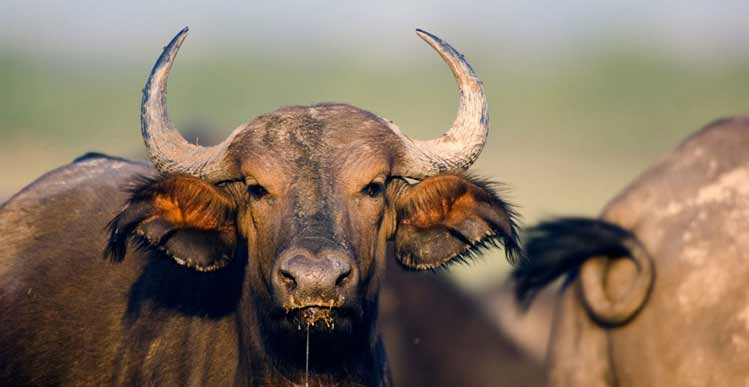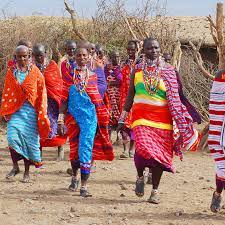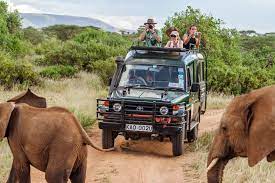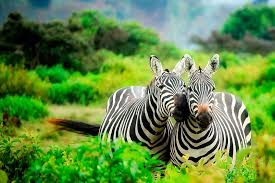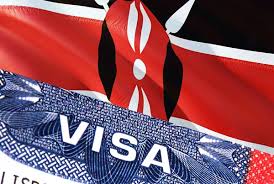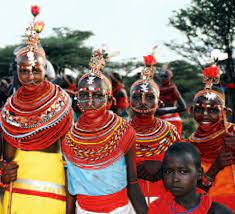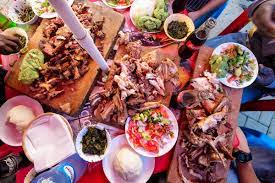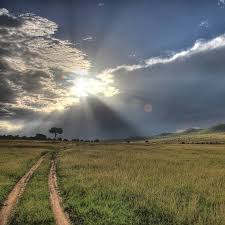Overview
Queen Elizabeth National Park is understandably Uganda’s most popular tourist destination. The park’s diverse ecosystems, which include sprawling savanna, shady, humid forests, sparkling lakes and fertile wetlands, make it the ideal habitat for classic big game, ten primate species including chimpanzees and over 600 species of birds. Set against the backdrop of the jagged Rwenzori Mountains, the park’s magnificent vistas include dozens of enormous craters carved dramatically into rolling green hills, panoramic views of the Kazinga Channel with its banks lined with hippos, buffalo and elephants, and the endless Ishasha plains, whose fig trees hide lions ready to pounce on herds of unsuspecting Uganda kob.
As well as its outstanding wildlife attractions, Queen Elizabeth National Park has a fascinating cultural history. There are many opportunities for visitors to meet the local communities and enjoy storytelling, dance, music and more. The gazetting of the park has ensured the conservation of its ecosystems, which in turn benefits the surrounding communities. Uganda’s Queen Elizabeth National Park is truly a Medley of Wonders!
Park At a Glace
Size: 1,978km².
Queen Elizabeth spans the equator line; monuments on either side of the road mark the exact spot where it crosses latitude 00. The park was founded in 1952 as Kazinga National Park, and renamed two years later to commemorate a visit by Queen Elizabeth II. The park is home to over 95 mammal species and over 600 bird species. The Katwe explosion craters mark the park’s highest point at 1,350m above sea level, while the lowest point is at 910m, at Lake Edward.
Best Time to Visit
Queen Elizabeth National Park is open all-year-long, but wildlife viewing is at its best from January to February and June to July (the Dry seasons). However, this scenic park is at its most beautiful in the Wet seasons from March to May and August to December. April, May, August and September are very wet months and during that time, the rain might interfere with your safari.
Best Time
January to February and June to July (Dry seasons)
High Season
June to September (There are many visitors in Uganda as this is a premium time for gorilla trekking)
Low Season
April, May, October and November (There are fewer people in the park)
Best Weather
June to July and January to February (Less rainfall)
Worst Weather
April, May and September to October (High rainfall, some roads become impassable)
January to February and June to July –Dry Seasons
- Wildlife is easier to spot as vegetation thins, and animals gather around water sources
- Drier trails make chimp trekking easier
- Sunny days are plentiful
- The best time for birding is late May to September
- Views aren’t as good due to the hazy air
Getting There
Located in western Uganda, shared by districts of Kasese, Bundibugyo and Bushenyi, Queen Elizabeth park is 1978km2 in size. The park lies 5-6 hours from Kampala on a surfaced road via Mbarara, and can be reached on a dirt road from Bwindi. It includes parts of Lakes Edward and George which are linked by Kazinga channeland other attractions. Accessing the park from Kampala is either on tarmac through Mbarara (420 kames) or Fort Portal via Kasese (410kms). The park is 5-6 hours from Kampala on surface road via Mbarara. This Uganda safari park can also be reached via Ishasha sector, which is south of Bwindi Impenetrable National Park. Queen Elizabeth NP is located about 410km/255mi north of Kampala. The direct drive takes about six hours, but your itinerary will most likely include some parks on the way. It is also possible to fly to any of the nearby airstrips of Kasese, Mweya or Ishasha by scheduled or chartered aircraft from Entebbe International Airport or Kajjansi Airfield near Kampala. You will enter Uganda at Entebbe International Airport (EBB), about 46km/29mi from Kampala, the capital city. Generally, your tour operator will arrange for your pick-up from the airport, and organize any further transportation required as part of your safari package.
Activities
Queen Elizabeth National Park is the second national park in Uganda and referred to as a “medley of wonders”. This is so because of its natural beauty set in the backdrop of the Rwenzori Mountains and the various activities that can be accomplished on a visit to this park.
Game Drives – Game viewing
Like other Savannah parks, game viewing is the specialty of Queen Elizabeth national park. It is home to big game in big numbers; the park has about 3000 Elephants, 5000 hippos, and there are over 10,000 of Cape Buffaloes, but there are also other small game including Warthogs, Waterbuck, Uganda Kob, Topi and even the rare semi-aquatic Sitatunga Antelope. To get the best out of your game drive and experience a classic African safari, the tracks through Kasenyi sector, the North Kazinga Plains and the Ishasha Sector offer virtually guaranteed buffalo, antelope and elephant sightings, along with warthogs and baboons. Taking an experienced guide in the early morning or at dusk is the most successful way to track down a pride of lions, and maybe even the odd leopard. A night game drive is also possible for nocturnal species.
Hot Air Balloon Ride
This unique experience is a recent addition on the list of activities in Queen Elizabeth national park. The adventure begins early in the morning when you leave your camp or lodge to get to the meeting point at the Kasenyi gate of Queen Elizabeth NP for 5:30am. This early drive in the dark is a chance to see nocturnal animals that live in and around the park and also gives you an aerial view of all the parks inhabitants. There are many other adventures in Queen Elizabeth Natuional Park and we will look at them in detail later including but not limited to the following;
- Chimpanzee tracking in Kaymbura and Kalinju forest
- Local community visit including coffee tour
- Hiking and guided nature walks
- Bird watching
- Boat cruise
- Lion tracking / Research
- Katwe salt works
Uniqueness
Queen Elizabeth National Park is truly a Medley of Wonders! Located in Kasese District of Uganda, this Uganda safari park has various ecosystems made up of sprawling savanna, shadowy, moist forests, lakes and fertile wetlands, which makes it a good home to various species of wildlife, primates and birds. Queen Elizabeth National Park lies against the back of the great Rwenzori Mountains with stunning and panoramic views that are made up of various crater lakes. These lakes are carved dramatically into the green rolling hills. When you visit, you will reward yourself with magical sights of the Kazinga Channel. This channel’s shores are infested with hippopotamuses, elephants and buffaloes. You will also see the Savannah plains of Ishasha, whose fig trees obscure tree climbing lions that are ever ready to knock on herds of the famous Ugandan Kob. Just like the sights and attractions, Queen Elizabeth National Park Uganda does have a rich cultural background too. There are many scenarios and opportunities for tourists to meet up with the local communities and be part of amazing cultural activities like traditional dances, storytelling moments, listening to traditional music and more. You can further engage in community projects and leave footprints behind. Named after Queen Elizbeth II, this park was previously named Kazinga National Park. The gazetting of Queen Elizabeth National Park has long ensured the conservation of its ecosystems for decades, which in turn benefits the surrounding communities. Some of the activities to carry out in this popular national park include wildlife viewing (primary activity) in Kasenyi, Mweya and Ishasha sectors, Chimpanzee tracking in the exhilarating Kyambura Gorge, Kalinzu forest or Maramagambo forest, Hot air ballooning and local community visits. Other interesting activities include hiking and nature walks, bird watching, launch cruises on the Kazinga Channel, lion tracking, a visit to the explosion crater and a visit to the Katwe salt works. Tourists can visit Queen Elizabeth NP at any time of the year but the best experiences are got during the months of June to September and December to January respectively. This wildlife park is not only among the best wildlife viewing destinations, but is also Uganda’s most popular tourist destination. When you go gorilla trekking in Bwindi, endeavor to add a visit to this lovely park as they are not so far away from each other. Its also easier to connect QENP with Kibale Forest National Park just in case you want to try out its Chimpanzee trekking experience

